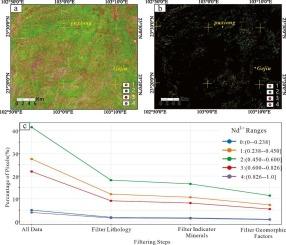多源光谱识别碱性岩中风化岩型铌稀土矿床——以云南普雄矿床为例
IF 3.6
2区 地球科学
Q1 GEOLOGY
引用次数: 0
摘要
风化岩型稀土元素(REE)矿床具有全球战略意义,中国供应全球90%以上的中重稀土。然而,亚热带地区的勘探受到茂密植被、多变风化强度和复杂岩性环境的阻碍。本研究以中国云南省普雄铌稀土矿床为研究对象,采用一种经济有效的方法,将ASTER和Sentinel-2多光谱数据与ALOS PALSAR DEM和GF-3 SAR图像相结合,解决了这些挑战。作为高光谱和航空方法的补充,我们的方法证明了从多源遥感数据中提取ree相关信息的可行性。利用带比分析、主成分分析(PCA)、约束能量最小化(CEM)、定向滤波和K-means聚类等技术,结合地质地貌数据圈定稀土元素潜在带。本研究的一个关键创新是使用Nd3+丰度作为Nb-REE定位的直接示踪剂,并通过包含指示矿物(如高岭石、蒙脱石、赤铁矿、绿泥石、方解石、伊利石和高岭石)的回归模型来改进预测。ALOS PALSAR DEM的集成实现了详细的地貌分析,而GF-3 SAR图像改进了对结构特征的检测,进一步细化了潜在区域的描绘。结果表明,富Nd3+区域与碱性岩、残坡沉积等有利岩性单元以及指示矿物组合丰度中高的区域具有较强的空间相关性。确定了长岭岗—白云山、嘉沙等6个高电位带,并与已知地球化学资料进行对比验证,证实了预测的准确性。提出的多因素约束模型强调了通过整合多源遥感和地质信息,对风化岩带稀土矿床进行可扩展和有效勘探的潜力,特别是在亚热带地区。该研究为加强不同成矿环境下的风化岩型铌稀土矿床的勘探策略提供了强有力的框架。本文章由计算机程序翻译,如有差异,请以英文原文为准。

Identification of regolith-hosted Nb-REE deposits in alkaline rocks using multisource spectroscopic system: A case study of the Puxiong deposit, Yunnan Province, China
Regolith-hosted rare earth element (REE) deposits are of global strategic importance, with China supplying over 90% of the world’s medium and heavy REEs. However, exploration in subtropical regions is hindered by dense vegetation, variable weathering intensities, and complex lithological settings. This study addresses these challenges by focusing on the Puxiong Nb-REE deposit in Yunnan Province, China, and by employing a cost-effective methodology that integrates ASTER and Sentinel-2 multispectral data with ALOS PALSAR DEM and GF-3 SAR imagery. As a complementary to hyperspectral and airborne approaches, our method demonstrates the feasibility of extracting REE-related information from multisource remote sensing data. Techniques including band ratio analysis, principal component analysis (PCA), constrained energy minimization (CEM), directional filtering, and K-means clustering were combined with geological and geomorphological data to delineate potential REE zones. A key innovation of this study is the use of Nd3+ abundance as a direct tracer for Nb-REE localization, enhanced by a regression model that incorporates indicator minerals (e.g. kaolinite, montmorillonite, hematite, chlorite, calcite, illite, and halloysite) to refine predictions. The integration of ALOS PALSAR DEM enabled detailed geomorphological analysis, while GF-3 SAR imagery improved the detection of structural features, further refining the delineation of potential zones. Results reveal a strong spatial correlation between Nd3+-rich areas and favorable lithological units, such as alkaline rocks and residual slope deposits, as well as regions with moderate-to-high indicator mineral assemblages abundance. Six high-potential zones were identified, including the Changlinggang-Baiyunshan and Jiasha areas, with validation by comparison against known geochemical datasets confirming the accuracy of these predictions. The proposed multi-factor constrained model highlights the potential for scalable and efficient exploration of regolith-hosted REE deposits, particularly in subtropical regions, by integrating multisource remote sensing and geological insights. This study provides a robust framework for enhancing exploration strategies for regolith-hosted Nb-REE deposits across diverse metallogenic environments.
求助全文
通过发布文献求助,成功后即可免费获取论文全文。
去求助
来源期刊

Ore Geology Reviews
地学-地质学
CiteScore
6.50
自引率
27.30%
发文量
546
审稿时长
22.9 weeks
期刊介绍:
Ore Geology Reviews aims to familiarize all earth scientists with recent advances in a number of interconnected disciplines related to the study of, and search for, ore deposits. The reviews range from brief to longer contributions, but the journal preferentially publishes manuscripts that fill the niche between the commonly shorter journal articles and the comprehensive book coverages, and thus has a special appeal to many authors and readers.
 求助内容:
求助内容: 应助结果提醒方式:
应助结果提醒方式:


